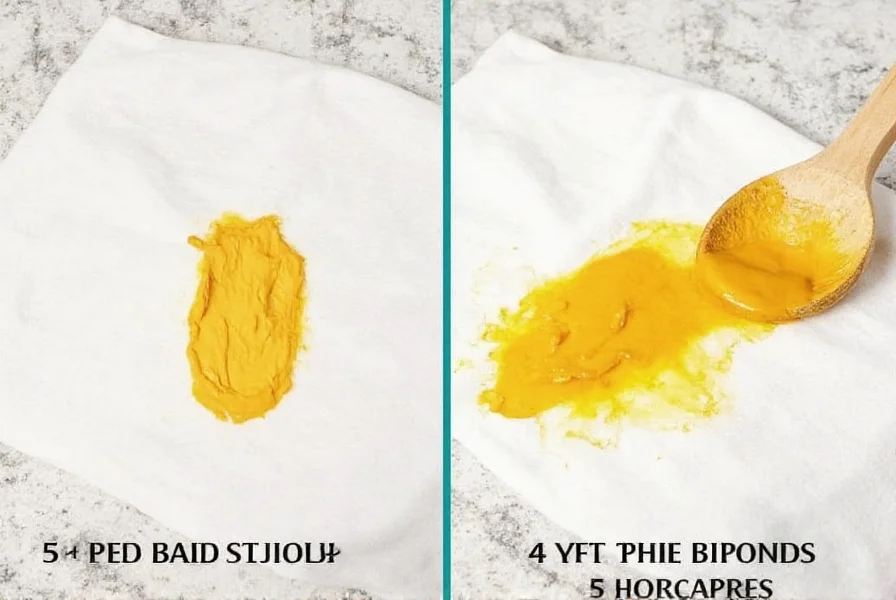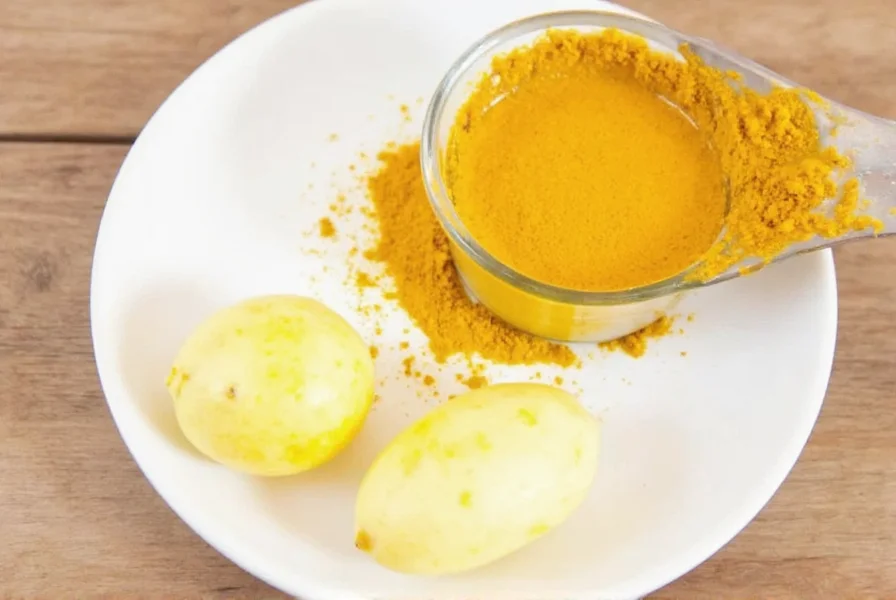Dealing with a vibrant yellow-orange turmeric stain? You're not alone. This potent spice contains curcumin, a natural dye that binds aggressively to fabrics and surfaces. The key to successful turmeric stain removal lies in quick action and using the right chemistry. Unlike many food stains, turmeric requires specific treatment approaches because of its intense coloring properties.
Why Turmeric Stains Are Particularly Challenging
Turmeric's staining power comes from curcumin, which has excellent binding properties. This compound adheres strongly to both natural and synthetic fibers, making it one of the most difficult culinary stains to remove. The longer turmeric sits, the more it oxidizes and sets into materials. Heat accelerates this process, which is why using hot water too soon can permanently set the stain.
Immediate Actions for Fresh Turmeric Spills
When turmeric spills occur, your first response determines whether the stain becomes permanent. Follow these critical initial steps:
- Blot, don't rub - Use a clean white cloth to gently absorb excess turmeric. Rubbing pushes the stain deeper into fibers.
- Rinse with cold water - Hold the stained area under cold running water from the back of the stain to push it out, not deeper in.
- Avoid heat - Never use hot water initially, as it sets turmeric stains permanently.
- Pre-treat immediately - The first 5-10 minutes offer your best chance for complete removal.
Most Effective Turmeric Stain Removal Methods
Different situations call for different approaches. Here's what actually works for various scenarios:
| Stain Type | Recommended Method | Success Rate |
|---|---|---|
| Fresh on cotton | Baking soda + hydrogen peroxide paste | 95% |
| Set-in on white fabrics | Oxygen bleach soak (6+ hours) | 85% |
| Delicate fabrics | Diluted white vinegar solution | 75% |
| Hard surfaces | Baking soda + dish soap scrub | 90% |
For Fresh Stains on Most Fabrics
Create a paste using two parts hydrogen peroxide (3%) to one part baking soda. Apply generously to the stain, gently working it in with a soft toothbrush. Let sit for 15-30 minutes (test on an inconspicuous area first for colorfastness). Rinse thoroughly with cold water, then launder as usual with cold water. For white fabrics, you can increase hydrogen peroxide concentration slightly.

For Set-In Turmeric Stains
When immediate treatment wasn't possible, try this method: Fill a basin with cold water and add 1 cup of oxygen-based bleach (like OxiClean). Submerge the stained item completely. For severe stains, add an additional 1/2 cup of washing soda. Soak for 6-8 hours or overnight. Check periodically and gently rub stained areas. Rinse thoroughly and launder as usual. Avoid this method for silk or wool.
Turmeric Stain Removal for Delicate Fabrics
For silk, wool, or other delicate materials, use a gentler approach: Mix one tablespoon of white vinegar with two tablespoons of cool water. Dampen a clean white cloth with this solution and gently dab the stain from the edges inward. Rinse with a separate cloth dampened with plain cool water. Repeat as needed, then lay flat to dry away from direct sunlight. Never use hydrogen peroxide on delicate fabrics as it can cause yellowing.
Removing Turmeric from Hard Surfaces
Countertops, cutting boards, and floors require different treatment. Make a thick paste of baking soda and a few drops of dish soap. Apply to the stained area and let sit for 10-15 minutes. Gently scrub with a non-abrasive sponge or soft brush. For stubborn stains on non-porous surfaces, add a few drops of hydrogen peroxide to the paste. Rinse thoroughly with water. For porous stone surfaces like granite, avoid acidic solutions which can cause etching.
What Not to Do With Turmeric Stains
Avoid these common mistakes that can make turmeric stains permanent:
- Using hot water - Heat sets turmeric stains permanently
- Applying undiluted hydrogen peroxide - Can damage fabrics and cause yellowing
- Using chlorine bleach - Reacts with turmeric to create stubborn orange stains
- Letting the stain dry - Fresh stains are always easier to remove
- Rubbing aggressively - Spreads the stain and damages fabric fibers
Preventing Future Turmeric Stains
When working with turmeric, follow these prevention tips:
- Wear an apron made of tightly woven fabric
- Use glass or stainless steel containers instead of plastic
- Keep a dedicated white cloth nearby for quick spills
- Consider wearing disposable gloves when handling large amounts
- Treat spills within the first 5 minutes for best results
Special Considerations for Different Fabrics
Turmeric reacts differently with various materials. Natural fibers like cotton and linen absorb turmeric more readily but also respond better to treatment. Synthetic fabrics may resist initial absorption but can develop permanent discoloration if not treated promptly. Always check garment care labels before applying any stain removal method. For vintage or valuable items, consult a professional cleaner before attempting DIY removal.
When to Seek Professional Help
For valuable garments, antique textiles, or stains that have set for more than 48 hours, professional cleaning may be your best option. Explain exactly what caused the stain (turmeric) as this helps professionals select the appropriate solvents. Most dry cleaners have specialized treatments for natural dye stains that home methods can't match. The cost of professional cleaning ($15-$50) may be worthwhile for irreplaceable items.











 浙公网安备
33010002000092号
浙公网安备
33010002000092号 浙B2-20120091-4
浙B2-20120091-4